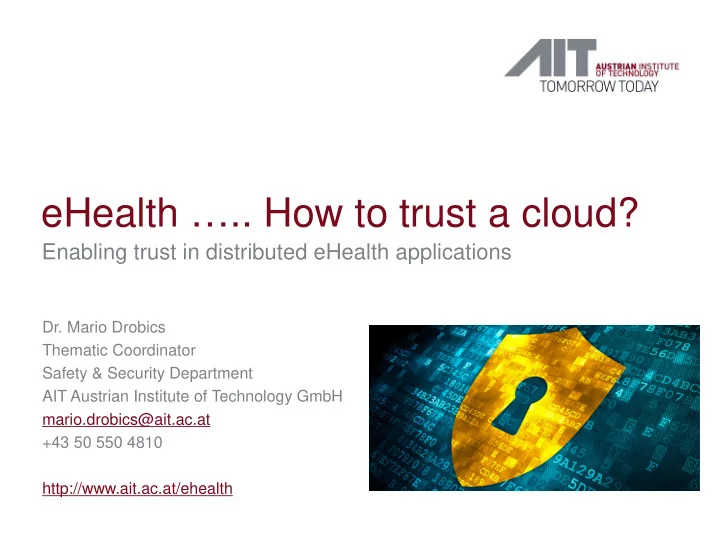

eHealth ….. How to trust a cloud? Enabling trust in distributed eHealth applications Dr. Mario Drobics Thematic Coordinator Safety & Security Department AIT Austrian Institute of Technology GmbH mario.drobics@ait.ac.at +43 50 550 4810 http://www.ait.ac.at/ehealth
Overview 1. Specifics of eHealth applications in the cloud 2. Enabling trust in distributed eHealth environments 3. IHE as a framework for enabling trust 4. Open issues & outlook
Distinctive Feature of Distributed/Cloud Applications Not all tasks can be secured using cryptography (e.g. access control, decision-making) Additional interface and areas of attack (e.g. administration interfaces, virtual networks, account management) Legal restrictions when hosting medical data in foreign countries Legal construction of subcontractors not very transparent Security policies hard to audit ⇒ High level of trust to the provider necessary
Distinctive Features of eHealth Application Processed data is very sensitive Highly personal data Potentially large number of effected persons High number of active users and (geographically) distributed nodes and sub-networks Specific use-cases (i.e. user might need to provide approval for data access) Need to access data in case of (personal & technical) emergency ⇒ Standard approaches are not directly applicable
Challenges for eHealth Applications Local nodes have highly varying security levels (clinics, surgeries, laboratories, etc.) Distribution of nodes hinders physical protection ⇒ Take-over of (privileged) nodes not preventable
Legal framework for eHealth Applications European Level ENISA (Directive 2013/40/EU) Patients' Rights in Cross-border Healthcare (Directive 2011/24/EU) Protection of individuals with regard to the processing of personal data and on the free movement of such data (Directive 95/46/EC) Protection of individuals with regard to the processing of personal data (Regulation (EC) No. 45/200) etc. National Level E.g. data privacy laws, EHR related laws, …
Reasons for establishing eHealth Services in the Cloud Scalability of the service Providing centralized data storage in the cloud Geo-redundancy is easier to establish Easier to operate and more cost-efficient Provide Software as a Service Homogeneous level of security Cost reduction due to centralized maintenance
Vulnerability to Attacks Currently, only few attacks with sever impact to system or user data known to the public No underlying business-model High degree of penalty if critical infrastructures are attacked Low acceptance of these attacks in the community This might change … Social or military conflicts, terrorism Unspecific attacks to cloud services might also infringe eHealth applications Increasing use of mobile devices and wireless communication
Ensuring Security By Design Compromise of nodes in large-scale networks is inevitable System design should limit effects of compromise Via cryptography Prevent forgery of data by using appropriate algorithms and transactions (e.g.. „bearer” vs “holder-of-key” model) Via system-policies Limit the amount of data retrievable by attacker, e.g. by limiting the access rights or the number of requests the attacker could perform. Via security systems IDS (Intrusion Detection Systems) may detect anomalies from the outside, even when attacker uses correct authentication.
Enabling trust in (healthcare) networks Authentication of users (role-based access) Authentication of nodes Authentication of transactions Multi-Factor Token Costs PKI/Digital Signature Knowledge-Based Kerberos Username - Password Very High PIN/User-ID High Medium Low Acess to summary Access to Local EHR Verification of Data Security Remote Clinical Entry of clinical research Transscription Demand
Security Concepts for Cloud Services Encrypted data transfer + Easy to set-up + High transaction security - Intrusion to data storage critical Separate (virtual) networks + Fraud detection on network level easy to set-up + Requires similar level of trust throughout the network • Encrypted data transfer & storage + High security + Full access control to data + Supports distributed storage - Access to emergency data difficult
Security Concepts for Cloud Services Encrypted data transfer & storage Data is de- / encrypted at the client High level of control can be established (e.g. access only with personal eCard) Homomorphic encryption supports limited computations on encrypted data Enables “need-to-know” principle
IHE – Integrating the Healthcare Enterprise Non-profit organization aiming to improve interoperability Provides interoperability-profiles based on use-cases Defines how established standards (e.g. HL7, DICOM) should be applied to these use-case IHE specifies How to enable interoperability Protect that interoperability mechanism from security risks NO security policies
IHE Profiles mapped to Security & Privacy Controls Audit Log Authentication Identification and Control Data Access Secrecy Data Integrity Non-Repudiation Patient Privacy Security & Privacy Controls Profile IHE Profile Issued √ √ √ √ √ √ √ Audit Trails and Node Authentication 2004 √ ∙ √ Consistent Time 2003 √ ∙ ∙ ∙ Enterprise User Authentication 2003 √ ∙ ∙ ∙ Cross-Enterprise User Assertion 2006 ∙ √ Basic Patient Privacy Consents 2006 √ √ ∙ Personnel White Pages 2004 √ ∙ ∙ Healthcare Provider Directory 2010 √ √ √ Document Digital Signature 2005 √ √ ∙ Document Encryption 2011
IHE Summary IHE does not support „encryption on storage“ i.e. encrypted cloud-storage has to be set-up „outside“ of IHE IHE design not optimized for cloud-infrastructures (e.g. need-to-know principle not considered) Limitations in trans-organizational / -national infrastructures ⇒ Separate solutions necessary to guaranty security if not all nodes are perfectly trustworthy
Outlook Cloud services need to adopt to eHealth requirements Establish relationship of trust between heath care and cloud service provider • Ensure privacy and confidentiality of hosted data • Transparent handling of data and policies • Ensure long-term availability & security of the data Support eHealth standards Confirm to (inter-) national laws
Your Ingenious Partner! Dr. Mario Drobics Thematic Coordinator Safety & Security Department AIT Austrian Institute of Technology GmbH mario.drobics@ait.ac.at +43 50 550 4810 http://www.ait.ac.at/ehealth
Recommend
More recommend